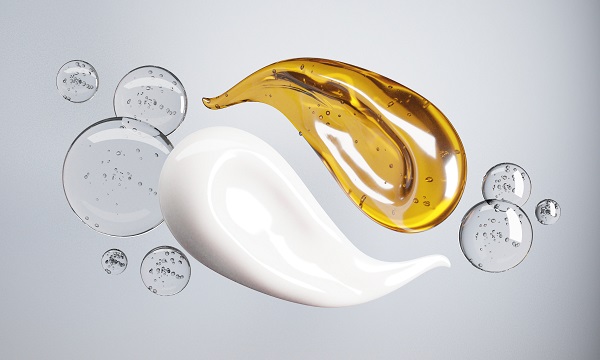Origins of emulsifiers in food and cosmetic industries
The Crucial Benefits of Emulsifiers for Smooth and Steady Combinations
Emulsifiers are crucial in creating smooth and stable mixes across numerous sectors. They reduce surface area stress between immiscible fluids, bring about enhanced texture and overall sensory experiences. In food and cosmetics, their duty extends past mere mixing; they likewise enhance shelf life and item integrity. Understanding the kinds and applications of emulsifiers discloses their importance in formulation processes. The nuances of their performance warrant further exploration.
Comprehending Emulsifiers: The Science Behind the Blend
Emulsifiers are commonly ignored in everyday food preparation and food production, they play a crucial role in stabilizing combinations that would certainly or else separate. Emulsifiers are substances that reduce surface area tension between 2 immiscible fluids, such as oil and water. They have both hydrophilic (water-attracting) and hydrophobic (water-repelling) residential properties, permitting them to interact with both phases. This one-of-a-kind particular allows emulsifiers to develop a stable user interface, protecting against the separation of fats and liquids.
Typical instances of emulsifiers include lecithin, commonly acquired from soybeans or eggs, and mono- and diglycerides. These compounds produce a consistent appearance in items like mayonnaise, salad dressings, and sauces. The science behind emulsifiers hinges on their capacity to develop a stable emulsion, which is essential for achieving desirable food top quality and life span. Comprehending the function of emulsifiers is important for food researchers and culinary specialists going for constant outcomes.
Culinary Applications: Enhancing Taste and Appearance
Emulsifiers significantly boost culinary applications by boosting both flavor and texture in a range of food products (emulsifiers). They play an essential role in creating steady emulsions, which are crucial for sauces, dressings, and mayo. By making it possible for the even distribution of fats and water, emulsifiers ensure that flavors are unified and well-blended, enhancing the general taste experience
In baked goods, emulsifiers add to a better crumb framework and boosted moisture retention, causing items that are appealing and soft. Additionally, they aid prolong rack life by stopping separation and keeping quality.
In dairy products, emulsifiers aid in producing smooth textures, vital for products like ice cream and lotion cheese, where mouthfeel significantly influences customer enjoyment. Overall, making use of emulsifiers in culinary applications not only boosts flavor profiles however also improves the sensory experience of different food items, making them much more enticing and enjoyable.

Aesthetic Uses: Developing Glamorous Solutions
When developing cosmetic items, the incorporation of emulsifiers is vital for attaining elegant and smooth appearances. These agents assist in the mixing of water and oil phases, producing secure emulsions that improve item efficiency and customer experience. Emulsifiers not only enhance the uniformity of creams and creams yet likewise add to the general sensory features, enabling a much more pleasant application and really feel on the skin.
Furthermore, emulsifiers play an important function in the reliable shipment of active components, guaranteeing that they stay uniformly distributed throughout the formulation. This uniform distribution enhances the product's effectiveness, giving targeted advantages such as hydration, anti-aging, and protection. The ideal emulsifier can pass on a preferred viscosity, avoiding separation and maintaining product integrity over time. Inevitably, emulsifiers are integral in developing high-grade cosmetic formulations that meet customer assumptions for deluxe and performance.
Kinds of Emulsifiers: All-natural vs. Artificial
Understanding the differences between natural and artificial emulsifiers is vital for formulators intending to maximize aesthetic products. All-natural emulsifiers, originated from plant or animal sources, include active ingredients like lecithin, beeswax, and numerous gum tissues. They are usually favored for their skin-friendly buildings and biodegradability. Additionally, they can boost the sensory profile of formulas, offering a more enticing appearance and feel.
In contrast, synthetic emulsifiers are chemically crafted to produce details capabilities and security. Typical examples include polysorbates and stearic acid. These emulsifiers commonly supply premium performance concerning emulsification effectiveness and shelf-life stability. They may elevate worries concerning skin sensitivity and ecological influence.
Ultimately, the option between natural and artificial emulsifiers depends on the desired product qualities, formula objectives, and customer choices, highlighting the relevance of comprehending their special buildings. emulsifiers.
The Role of Emulsifiers in Food Preservation

Tips for Making Use Of Emulsifiers Efficiently in Recipes and Products
When using emulsifiers in items and dishes, choosing the proper type is necessary for attaining preferred outcomes. Furthermore, utilizing proper blending methods can considerably improve the stability of emulsified mixes. Recognizing storage space techniques and shelf life guarantees the longevity and effectiveness of these emulsifiers.
Picking the Right Emulsifier

Choosing the appropriate emulsifier can greatly boost the structure and stability of a combination, as the ideal option depends on the details ingredients and preferred end result. Numerous factors influence this decision, consisting of click resources the kind of fats or oils, the existence of water, and the target uniformity. For example, lecithin is perfect for dressings and sauces, while xanthan gum tissue works well in gluten-free baking. In addition, the emulsifier's compatibility with other active ingredients plays a significant role in accomplishing the wanted security. It is vital to take into consideration the temperature level variety of the application, as some emulsifiers perform far better under particular problems. Inevitably, recognizing the attributes of each emulsifier will certainly cause extra reliable formula in dishes and items.
Appropriate Blending Strategies
Utilizing efficient mixing techniques is crucial for accomplishing excellent emulsification in recipes and products. It is important to introduce emulsifiers slowly, enabling them to spread equally throughout the mixture. High-shear blending approaches, such as making use of an immersion or a blender mixer, can enhance emulsifier performance by breaking down fat beads. Preserving a regular temperature level throughout mixing additionally help in achieving a stable emulsion, as fats and liquids can blend a lot more properly when warmed. In addition, including ingredients in the proper order-- starting with the liquid stage followed by the fat phase-- ensures also distribution. Mixing should continue till the wanted consistency is reached, avoiding over-mixing, which can lead to splitting up. Proper methods eventually lead to smoother, more steady solutions.
Storage and Service Life
The effectiveness of emulsifiers can considerably improve the high quality of mixes, proper storage and focus to shelf life are important for keeping their efficiency. Emulsifiers ought to be stored in a trendy, dry atmosphere, far from straight sunshine and dampness, which can deteriorate their residential or commercial properties. It is advisable to maintain them in impermeable containers to protect against contamination and oxidation. Additionally, checking the expiry days and adhering to recommended storage space guidelines can maximize their performance. Routine analyses of texture and security in mixtures can suggest whether the emulsifier is still operating efficiently. By adhering to these storage methods, individuals can ensure that their emulsifiers continue to be potent, leading to continually smooth and secure combinations in dishes and items.
Regularly Asked Inquiries
Are Emulsifiers Safe for Individuals With Dietary Restrictions?
Emulsifiers can be risk-free for individuals with dietary restrictions, depending upon their source and composition. It's important for those with allergies or certain nutritional view website requirements to very carefully review active ingredient tags and seek advice from medical care professionals.
How Do Emulsifiers Affect the Shelf Life of Products?
Emulsifiers boost the life span of products by stabilizing combinations, protecting against splitting up, and reducing putridity. Their capability to preserve uniformity assists guarantee durability, eventually protecting flavor, structure, and general high quality in numerous food things.
Can I Make Emulsifiers at Home?
Yes, home made emulsifiers can be created utilizing all-natural ingredients like egg yolks, mustard, or honey. These options can assist blend oil and water, but results might vary based upon the specific dish and strategy utilized.
What Are Typical Emulsifier Allergies to Look For?
Usual emulsifier allergies consist of reactions to soy lecithin, egg yolk, and dairy-based emulsifiers. People with level of sensitivities may experience signs like hives, stomach distress, or breathing issues upon exposure to these active ingredients in different food.
Exactly How Do Emulsifiers Effect Nutritional Value?
Emulsifiers can affect nutritional value by boosting vitamins and mineral absorption and bioavailability - emulsifiers. Too much use may lead to vitamins and mineral loss or discrepancy, click for source possibly affecting health and wellness results, specifically in processed foods where they are prevalent.
Emulsifiers significantly improve culinary applications by improving both flavor and appearance in a selection of food items. In dairy products, emulsifiers help in producing smooth appearances, essential for items like ice lotion and lotion cheese, where mouthfeel greatly impacts customer enjoyment. In the domain name of food conservation, emulsifiers play a considerable role in keeping the top quality and shelf-life of numerous items. In items like salad dressings and sauces, emulsifiers help to preserve structure and flavor stability over time, making certain that the food remains attractive to consumers. Typical emulsifier allergic reactions consist of reactions to soy lecithin, egg yolk, and dairy-based emulsifiers.